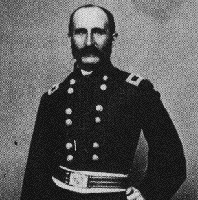
|
|
VITAL STATISTICS
|
BORN: 1824 in Greenfield, MA.
DIED: 1908 in the District of Columbia
CAMPAIGNS: Port Royal, Harper's Ferry, Defenses during Shenandoah Valley.
HIGHEST RANK ACHIEVED: Brigadier General.
(Carried out the first orders issued by the War Department athorizing the recruitment of 5,000 Black soldiers for Federal service.)
|
|
BIOGRAPHY
|
| Rufus Saxton was born in Greenfield, Massachusetts, on September 19, 1824. He graduated from the US Military Academy in 1849, and fought against Seminoles in Florida and on frontier duty. Saxton took part in the Northern Pacific Railroad survey, was promoted to 1st lieutenant, and held various surveying and fortification assignments. He taught artillery tactics at West Point for a year, and spent several months on duty in Europe. In 1861, before the Civil War began, Saxton commanded a detachment of artillery at the arsenal in St. Louis, Missouri, and helped disband secessionists at Camp Jackson. Promoted to brigadier general on April 15, 1862, he commanded the defenses at Harpers Ferry during "Stonewall" Jackson's Shenandoah Valley Campaign. Saxton served in various posts with the Department of the South, including the independent military governorship of the islands off the coast of South Carolina and Georgia. In that post, he was ordered to recruit and organize up to 5,000 black soldiers for Union service. This was the first such order from the War Department. While Saxton was opposed to slavery, he was not an abolitionist. He worked hard to recruit and train African Americans, insisting that they be treated with respect and be enlisted on an equal basis with whites. Gradually, African Americans began to trust him, and he was overjoyed when some of his black recruits performed well in combat duty in November of 1862. Their success produced public support, and Saxton was able to train his troops well and form the 1st South Carolina Colored Volunteers, the first full-strength black regiment officially mandated in the Union army. In addition to his work on behalf of black soldiers, Saxton was concerned for the welfare of black civilians. He tried to assign them to parcels of land on Sea Islands estates, which had formerly been owned by Confederate plantation owners. While they were still termed "contrabands," the former slaves were given seed and tools by the government, and many were able to support themselves and even sell surpluses. In exchange, they raised an allotted amount of cotton for the federal government's use. After Sherman's occupation of Georgia and the Carolinas, Saxton was transferred to the Freedmen's Bureau, where he served as assistant commissioner in South Carolina, Georgia and Florida. He delayed the restoration of plantations which were being farmed by former slaves to their former owners, since he hoped that Congress would pass laws which would distribute the confiscated estates to former slaves. President Andrew Johnson removed Saxton from his position, ending his attempts to help former slaves adjust to freedom and self-sufficiency. Saxton continued with the military, including service in the Quartermaster Department of the Regular Army, and retired from active duty in 1888. He died on February 23, 1908, at his home in the District of Columbia. |
|

